|
The philosophy behind the Robosail Pilot
|
From the outside the Robosail Pilot just looks like a
black box. A lot of sensor information goes in, it is
processed and used to control the rudder. |
Inside there is a complex architecture with lots of modules that contain the knowledge of experienced helmsmen. |
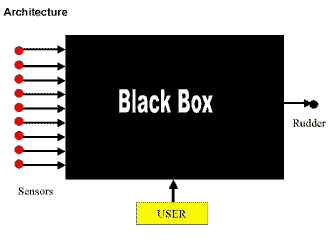 |
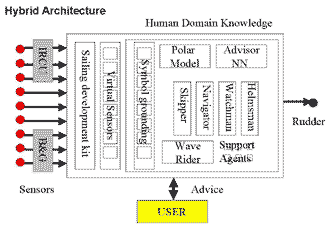 |
Why is it so difficult to develop a good autopilot system for a modern ocean racer?
Sailing is a complex sport and it takes many years of experience to become a good helmsman. Sailing is typically a skill. You have to know a lot of things to become a good helmsman but above all you have to feel the boat, the wind an the waves. Every boat is different, every wheather situation is different and there is a myriad of factors that have to be taken in to account to sail a boat optimally. Sailng cannot be learned from a book. Unlike a game like chess, where the optimal next move in principle can be calculated by a computer, in sailing there are no clear rules that define what the best thing to do next is. Therefore it is difficult to teach a computer (or any machine) to sail a boat optimally. Yet it is clear that, specifically for the single handed sailor, a good autopilot that really optimizes the speed of the boat would give a big advantage.
A learning autopilot
The solution is to make a learning autopilot that can constantly improve its performance and that can adapt itself optimally to the specific features of the boat. The autopilot ideally should be able to feel the boat just like an experienced helmsman does. Suppose that one wants to constuct such an autopilot. What would it look like? What information would it need and which sensors would have to be installed. Let's have closer look at what sailing really is.
Sailing an ocean going light displacement yacht
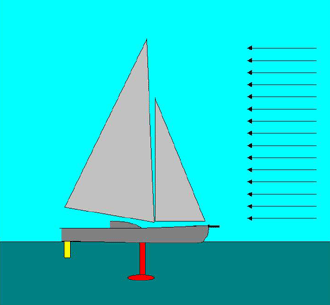
Sailing is possible when there is a difference in speed between two media: water and air. Both media show turbulent chaotic behaviour that is not completely understood from a scientific point of view. A sailing yacht can bee seen as a floating device with two wings: a small wing, the keel, in the high density medium water and a large wing, the sail, in the low density medium air. The boat has to be able to perform optimally in a wide varaiety of conditions, from wind speeds of a couple of knots to hurricane wind of over 50 knots. When there is wind the surface between the two media will become agitated: waves. It is the task of the helmsman to find an optimal course trought the waves. Therefore he has to anticipate the waves. He must be able to feel them and to predict when a new wave will reach the boat. The Robosail pilot feels the motions of the boat in 6 dimensions and has a sophisticated software routine that predicts the movements caused by the waves. The autopilot uses this information to steer the boat more optimally.
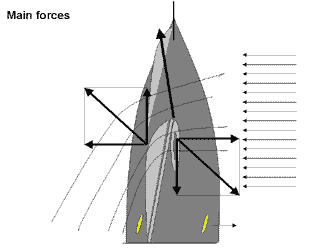
At every moment the forces on the sails and the hull are in a state of rapidly shifting balance. The wind excercises force on the sails, this force is compensated by forces on the hull. Since the lateral resistance of the hull is much bigger than the longitudinal resistance the boat will move forward as a result. Due to variations in the force and direction of the wind, the dynamic behaviour of the hull, and movements of the waves the helmsman must must constantly adapt to new situations. An autopilot that aims a a similar performance must have an advanced set of highspeed sensors that constantly process information about the environment. Furthermore, the forces are different for each boat and each wheather situation: only an adaptive pilot that can react to new information and learn from past experience can hope to gain a performce that is colse to the best human helmsman.
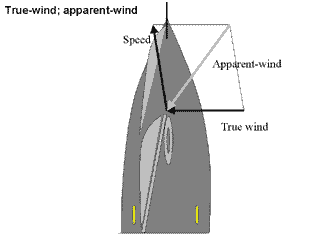
As a result of the speed of the boat the apparent wind (the wind that is measured on the moving boat) will change. Especially for modern race yachts that sometimes sail faster than the windspeed this effect is important. Downwind the difference between true and apparent wind direction can be more than 60 degrees. This is the reason that windvane pilots are of no use on a modern singlehanded yacht. A yacht that is in optimal trim for the current apparent wind at high speed will be completely at loss when it looses its speed as a result of hitting a wave or broaching (turn sudenly to windward). An autopilot that under these conditions simply tries to maintain the true wind direction (or worse: compass course) performs very badly. The autopilot must 'know' in what condition the yacht is and act accordingly. If a yacht has lost speed because of broaching the autopilot should first gain speed on the basis of the apparent wind and return to true wind later.
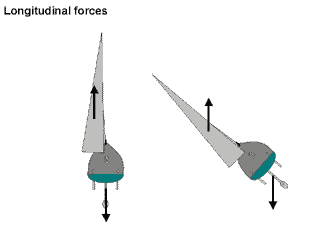
If the yacht heels, the propulsion vector in the sails will be working outside the main lateral plane of the hull. As a result the yacht will have a tendency to luff. The helmsman might even lose control over the yacht in such a situation. A good helmsman will take careful notice of the changes in the heel of the boat and anticipate such events. An autopilot that has to perform the same task has to have a very sensitive heel sensor and adequate software routines to react to the changing environment.
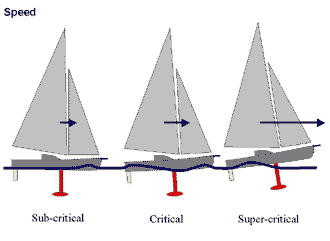
When a boat starts to move through the water is it creates a wave at its bow. When the speed is increasing the wave becomes bigger. At a certain critical speed (for the Robosail this is about 8.5 knots) the boat cannot go faster without climbing it's own bow wave and lifting itself out of the water. This takes a lot of energy. Older waterdisplacement yachts never reach this stage. If they are towed at speeds beyond their normal water displacement speed their hulls might be seriously damaged. Modern light displacement yachts like the Robosail can easily reach supercritical speeds far above 20 knots. The record is somewhat over 26 knots (close to 50 km/ph !!). These phase shifts in speed are very demanding for an autopilot. Under high speed the rudder is much more effective a and rudder movements have to be adapted.
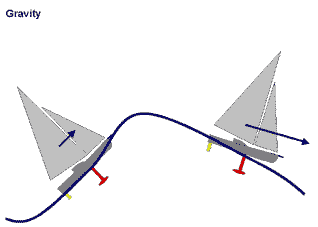
Then there is the effect is simple gravity. Upwave the boat is slowing down. Surfing down a wave a boat may easily reach super critical speed and dive into the next wave. The helmsman/autopilot has to anticpate these events. Robosail's waverider software assists the autopilot in these conditions.
These examples show why steering an ocean going light displacement yacht is a difficult task. The Robosail Sailing Lab enables us to test our equipment under extreme conditions in order to make the Robosail products, better, more reliable and safer.
Back to top
|

